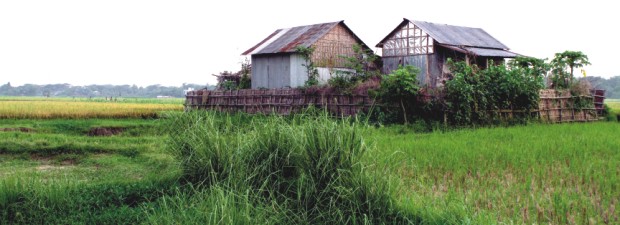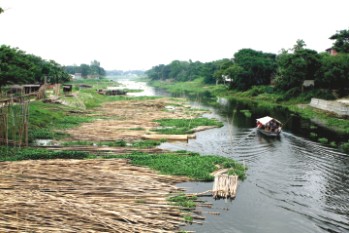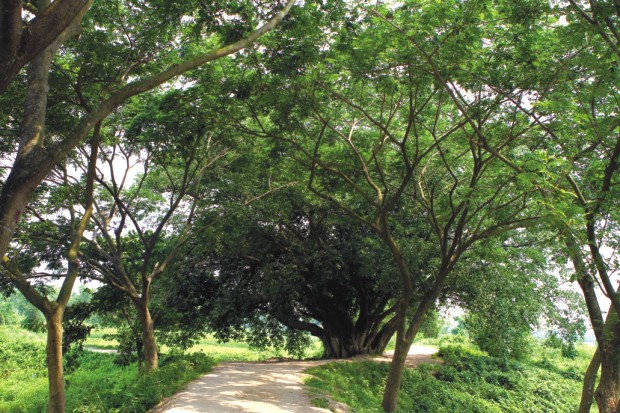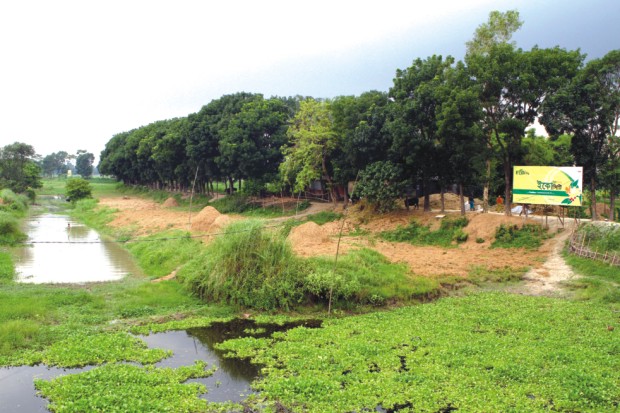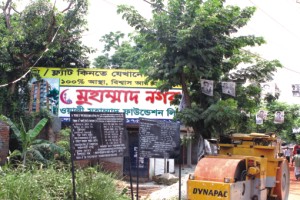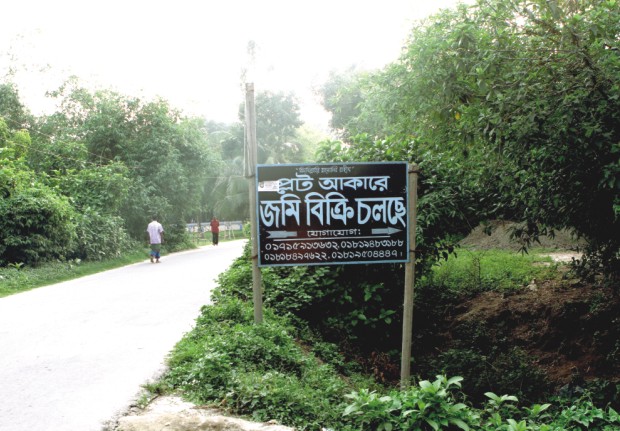| Home - Back Issues - The Team - Contact Us |
 |
| Volume 10 |Issue 21 | June 03, 2011 | |
|
|
Cover Story
Threatened by the Urban Monster Within the last five years Keraniganj has dramatically changed. As if a long dormant monster of unplanned urbanisation suddenly woke up to swallow this beautiful suburban area, hardly minutes drive from the city centre. In the south west of the city just across the river Buriganga, most of the 166.87 square kilometres area of the Keraniganj Upazila represented, the other day, a veritable rural Bangladesh. For years, it shyly hid away from the curse of our unplanned development. Morshed Ali Khan photos: Zahedul I Khan The Beauty From Brahman Gacha to Hazratpur and from Ruhitpur to Zinzira and throughout its 399 villages, most landscape of Keraniganj has been an eye soother. The Dhaleshwari, still reasonably unpolluted and flowing on one side and the polluted Buriganga on another are now fighting a seemingly losing battle to keep off the enemy. The history of Keraniganj travels back to the times of Nawab Sayesta Khan in the 18th century. Many believe the name derives from the clerical staff quarters of the nawab's administration built across the river Buriganga. The word Kerani is the Bangla equivalent to clerks.
The two major rivers encircling Keraniganj have been the main sources of water for hundreds of natural canals and water bodies crisscrossing the area. Only the other day one could hire a boat from the city's Rayer Bazaar and travel anywhere in Keraniganj. The fantastic network of canals was also the breeding grounds for hundreds of local species of fish. “At any time of the year you could throw a net in the water of the canals or river and catch shrimps, golsha, bain or many other fishes,” Jalal Mia of Atir bazaar recollects. So rich were the water bodies that the villagers in Keraniganj hardly bought fish from markets. Then the canals blessed them with a formidable transportation system and helped them irrigate the fields round the year, yielding huge amounts of agricultural produces for a handy city market. Age old banyan trees still provide shelter for birds and shed for the traders and farmers who flock the Kalatia Bazaar every day. Till today farmers from the villages bring in their farm produces and find wholesale and retail buyers from the capital. The homing pigeons on sale at the bazaar round the year is a legacy of the locality's characteristic which strongly links them with the main Dhakaia population.
Not far from Kalatia Bazaar in the middle of the vast paddy fields, away from villages are the strangest of water reservoirs surrounded by age old trees. Locally known as danga, these reservoirs were dug years ago to lure fishes invading the paddy fields during every flood season. At the end of each flooding, the owner of the danga sold the fish for hefty profits. The isolated dangas of Keraniganj till today attract a wide range of birds and reptiles. Bushy surroundings of the dangas still generate curiosity among the new comers, particularly wandering city dwellers looking for a respite from the urban hustle and bustle. In a place called Shutkir Tek, two age old banyan trees drape each other in the middle of an intersection of three earthen roads. Once a year, the Hindu community comes here to worship the trees. The paddy fields and thick bushes and some dangas nearby make the area even dreamier. Till today, as the sun sets the howling of foxes can be heard here. Local people fearing attack from the starving foxes do not venture out alone. Enter the monster The urban monster first started invading Keraniganj from Zinzira after our independence in 1971. As millions poured into Dhaka for jobs and shelters, Zinzira became the hub of the new migrants ready for any jobs that would ensure sustenance. Innovative thoughts were abundant. Ideas to replicate anything from a Japanese fountain pen to life saving drugs, from Toyota spare parts to Scotch Whisky spread roots quickly. Soon Made-in-Zinzira became a household name. Jokes about Zinzira's clandestine industries of counterfeits rolled from house to house. Made in Zinzira symbolised anything dubious in the Bangalee society. The industries in Zinzira evolved from the slums and slowly spread deeper into the villages. Over the years many of these counterfeit small industries were recognised by the government agencies and registered under the law of the land. There was even an initiative to institutionalise the Zinzira industries and recognise the skilled workforce involved with them.
Along with the new arrivals in the counterfeit industries Keraniganj's law and order started to deteriorate. Wanted criminals readily found a safe haven there. Reports of violent crimes among the syndicates controlling the booming businesses made headlines.
Keraniganj promised cheap housing for the hundreds of thousands of displaced men and women from rural Bangladesh in the early days after the liberation. A new breed of population started pushing the original inhabitants of Keraniganj for room. Many of these poor migrants rose to see prosperity and fame.
Mohammad Qaiyum, an established businessman from Kholamora, says his father Sid Mia came to Zinzira in 1972 from Bhola and worked in a battery factory in Zinzira and lived in a boat with other workers nearby. “When my father himself became the owner of a battery factory he bought this five katha plot for Tk 5000,” says Qaiyum, who shares the family's two-storey building on the same plot with his brothers near Kholamora. Like for Sid Mia, Keraniganj was a promising place for thousands of poor people dreaming of owning a piece of land near the capital. Haji Julhash, an original land owner of Keraniganj and a businessman from Taranagor says that twenty years ago the enterprising settlers from elsewhere in the country bought up thousands of small plots everywhere in Keraniganj.
“There was no bridge anywhere on the river Buriganga and land was so cheap here that anyone could afford it,” says Julhash. The rural lifestyle of Keraniganj gave birth to dozens of traditional folk poets, singers, composers and musicians. There isn't a village in Keraniganj where a Dewan (singer-cum-musician) or a musician is not around. The legendary Rajjab Dewan, Khaleque Dewan and the controversial Matal Razzak are some of the household names in Keraniganj. Matal Razzak, a poet, composer and a singer, in his lifetime wrote hundreds of songs and sang them in public places with packed audiences. Matal Razzak became the target of religious zealots when one of his songs challenged the religious clerics by saying, “oh moulanas, God cannot be confined within the place of worship only; but God prevails everywhere in this universe”.
Throughout the winter, villagers thronged night long singing parties under open skies where groups of Dewans performed. The sound of live drumbeats coming from one or the other villages traveled far, piercing the tranquility of the nights.
While the Buriganga is constantly being filled with millions of gallons of liquid and solid toxic wastes every day, the river Dhalashwari by the Khrakandi village somehow escapes from the onslaught of pollution, at least for the time being. Meanwhile, the Dhalshwari keeps offering, in the winter, one of the fast waning river sports of the country — river angling. During winter, anglers flock the Dhaleshwari. Like many rivers, the Dhaleshwari is a breeding ground for the pike (boal) and anglers throng there for fishing at night. In winter nights, the flickering hurricane lanterns dotting both banks of the river are obvious signs of anglers patiently attending their lines. Last year an angler from Khjarakandi stunned the villagers by catching a pike weighing 30 kilograms. It took the elderly angler nearly two hours to beach the huge fish.
The monster in fury The scenario started to change as soon as the second Buriganga bridge was completed at Babu Bazar. The final nail was hammered on the fate of rural Keraniganj when the third Buriganga bridge at Basila was completed in 2010. During the construction of the bridge, foresighted city dwellers descended in numbers in weekends exploring possibilities of investments in Keraniganj. They crossed the river from Basila ghat on traditional boats and ventured into the rural Keraniganj in search of land. As the workers worked long shifts on the bridge, Keraniganj was put on sale. Its paddy fields, agricultural lands, canals, rivers, low lying areas and public land — all were on the menu. Suddenly, farmers cultivating their own lands and leading a humble lifestyle woke up to see cash in hand. The modest settlers commuting to the city regularly for making a living found out their land prices were soaring beyond imagination. Slowly but surely Keraniganj started to slide from the lap of our rural mother. Within the last five years, signboards started to appear everywhere in Keraniganj. In the rivers, canals, paddy fields and public lands thousands of signboards announcing the names of new owners, particularly real estate developers appeared every day. As soon as the Basila bridge was completed 17 months ago, land filling became the main activity of Keraniganj. Within the period of two years prices of land jumped from Tk 1 lakh per katha on an average to up to Tk 30 lakh per katha for a land adjacent to the main road. The paddy fields or places without any road now sell for up to Tk 5 to 7 lakh per katha. The phenomenal growth defied all norms of planning. There are localities in Keraniganj where new houses have been built without proper access road, drainage or any other amenity. Civil engineer Minhazul Haque works for a real estate developer in Dhaka. In 2005 he bought a piece of land measuring 15 kathas in Ruhitpur area for Tk 1 lakh per katha. He says that now he is thinking of selling his plot and moving out of the area as none of his neighbours agree to leave space for an access road to his plot. “Nonetheless I can sell the plot for Tk 12 lakh per katha and buy a flat in Dhaka instead, because unplanned growth of the area is creating a nightmare here,” says Haque, “ Everyone here is constructing building everywhere and if you ask them where the road is, the usual response is 'oh that will come automatically',” he adds. In the villages, hundreds of plots were created by quick land fillings. New localities appeared everywhere without the slightest regard for aesthetics. In the middle of the paddy fields cluster of homes came up within a matter of days. Nobody knows what the consequences would be once these areas are built up. Interestingly, as most of the canals crisscrossing Keraniganj have been filled up, bridges and culverts which were built on top still lie there intact. In Atir Bazar authorities are not repairing the dilapidated bridge because the canal below is soon to be filled up.
The authorities In the master plan of the city, all looks immaculate in Keraniganj. Highways, planned residential and industrial zones, open spaces, canals and flood flow zones are so neatly defined. Keraniganj comes under the purview of the 1,528 square kilometers of the Dhaka Metropolitan Development Plan (DMDP), an outcome of a Tk 13-crore project completed by Rajuk in 1995. For six years from 2004 four consultants appointed by Rajuk laid down the Detailed Area Plan (DAP) at a cost of more than Tk 25 crore. The idea was to control unplanned urbanization and enforce a healthy guideline for growth of the city. The unplanned growth of Keraniganj and all other suburban localities is a vivid reminder of the ludicrous state of our authorities, entrusted to govern. Professor Jamilur Reza Choudhury, a civil engineer and an expert on urban issues says that immediate implementation of DAB is indispensable if we want to avoid an urban disaster. “I have recommended reviewing the DAP, accept whatever damage has been inflicted and prevent further damage to the urban landscape,” says Choudhry. The environmental activists are protesting against unplanned urbanization and demanding immediate implementation of DAP but nothing seems to be happening, Choudhury added. “How else can you create pressure on the government to wake up and save our environment.” There is still time for the government to come forward and save Keraniganj from becoming an urban ghetto. Otherwise, we are looking at an opportunity lost for ever. Copyright
(R) thedailystar.net 2011 |
||||
